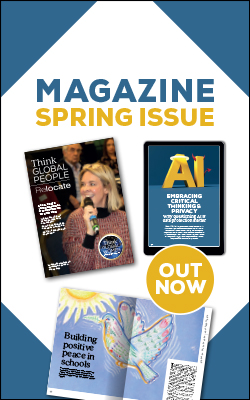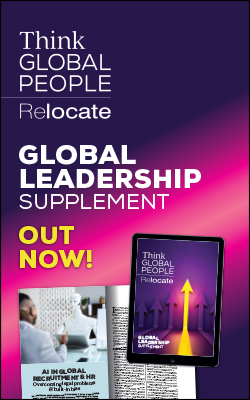Global mobility policies: Current trends
Short-term assignments and international one-way transfers are on the rise. For employers reshaping their global mobility policies, what opportunities and risks do these new forms of mobility present? Dr Sue Shortland comments on recent developments in alternative assignments and policy design.

This article is taken from the Autumn 2024 issue of
Think Global People magazine
Click on the cover to access the digital edition.The use of alternatives to the traditional long-term assignment is increasing. International permanent moves are attractive to employers because of the value for money they present when compared to the traditional expatriate assignment model.Short-term assignments - typically from three to 12 months, but maybe slightly shorter or longer - have become particularly prevalent, while commuter assignments remain a popular choice.Given the importance of cost, compliance and flexibility in global mobility, it is easy to see why these dynamic additions to the traditional global mobility policy suite have grown in recent years. But what are the key considerations and can technology and tools like AI help global mobility policy redesign and administration?
Short-term assignments
The use of short-term assignments and global mobility professionals’ involvement in their administration has grown significantly over the past few years. Short-term assignments are appealing from a talent perspective because they enable rapid deployment. They are generally thought to be more cost-effective than long-term assignments and are primarily used for project-based work, but also to transfer knowledge and skills.Short-term assignments can also provide career growth and development for employees. They offer employers flexibility, for example, in meeting employee requests, as well as improve equity, diversity and inclusion in the assignee workforce. Short-term assignments can be used for early career development moves too.Short-term assignments are typically unaccompanied and have home-based terms and conditions applied to them. However, they do present employers with challenges, particularly in relation to managing costs, extensions and tax issues.These factors are interrelated. Anyone opting for a short-term assignment needs to be clear that tax and compliance must be carefully considered and checked out ahead of a move taking place, as well as linked with appropriate tracking technology so that any extension to the assignment is managed effectively. Wellbeing is also a vital consideration because family separation is stressful.Read related articles
- Global mobility supply and demand: What is happening in the corporate world
- Tech-focused, sustainable and personalised – here are the emerging trends in serviced apartments
- The global mobility function: well-being, talent and inclusion implications
Commuter assignments
Commuter assignments are among the options employers and employees are using primarily for project-based work and to provide flexibility for employees. As with short-term assignments, they can also be used to promote career growth and development and in response to employee requests. They are commonly used for locations where it might be difficult to relocate an accompanying family.Commuter assignments are, by nature, unaccompanied. Yet long-term travel to service an assignment or project does represent considerable wear-and-tear on employees who need to travel regularly to and from their host locations.Frequent travel and family separation also cause family disruption and stress. So, if commuter assignments are to be used over the long term, then there should be regular check-ins with employees to ensure their wellbeing is being looked after.Cost-effectiveness
Short-term assignments and commuter arrangements are typically considered to be cost-effective ways of servicing international mobility.It is important to ensure that cost projections are carried out and that comparisons are made between these and long-term assignments. For example, a long-term assignment of one year’s duration, when compared with a short-term assignment or a commuter arrangement of similar length, may not prove to be that much less cost-effective.The mix of the package elements will be different, but additional costs that might flow from travel arrangements and compliance may raise the cost associated with the more flexible approaches to mobility beyond what might be originally expected.Permanent transfers
One aspect of global mobility gaining prominence is the use of a permanent transfer or one-way international assignment instead of a traditional long-term assignment. In such circumstances, the use of a permanent move would typically be on local terms, although there will be costs associated with the transfer of the employee and any accompanying family members to the new location, as well as set-up costs such as finding accommodation in country.While it is likely that the organisation will need to provide support for the start-up of this type of arrangement, once established, the employee and family are unlikely to receive a large amount of ongoing support compared with what might have been provided under a long-term assignment policy.As such, the use of permanent transfers where an assignment is envisaged to be long-term is generally considered to be more cost-effective than providing a full, home-based, long-term assignment package.An issue that needs to be considered when using one-way international transfers is the location where the employee and accompanying family members will be based. For instance, whether or not accompanying partners can work and children can find an appropriate school. Families will need to cover the cost of living in the new host location on a permanent transfer basis. So, two incomes will most likely be required if there is a lack of other supporting allowances and benefits that would have otherwise flowed from a long-term assignment policy.Given that companies wish to transfer their talent effectively and ensure that they are productive in the new location quickly, support must be tailored to ensure that families can make this transition to local terms and conditions smoothly. If the assignment appears to be undersupported financially, it is unlikely to be attractive. Where this type of policy is used, employees need to be motivated by the support and role on offer if they are to accept the posting and remain in post once they have accepted the role.Cash versus care
A further trend that has become apparent recently is the use of lump sums to support international transfers. It can be easier to provide a lump sum than tailored benefits and support services. It is also argued that employees like lump sums because it gives them flexibility to spend as they see fit. Of course, employees may not spend wisely and there are tax implications in the lump-sum approach.It is interesting to note that, having seen a move towards greater use of lump sums, there is now debate as to whether a ‘care’ or ‘cash’ approach is better. Lump sums can support budgeting and potentially speed up the recruitment process. However, the provision of a lump sum is not particularly helpful for anyone with complex needs. Time and effort need to be spent on finding appropriate services and this will detract from productivity in the role.A care approach – where service providers are commissioned to support employees and their families get started and settled in the new location – can ensure greater productivity and also support family wellbeing. It can also ensure that valuable company funds are spent on appropriate benefits that are aligned with a company’s culture and values. A care approach can also help to foster diversity and inclusion, thereby widening the potential talent pool.AI in policy design
A further policy design development is the rise of artificial intelligence (AI) programmes to help plan and write policy documents. The use of AI can improve the efficiency of the global mobility function because it can be used for operational tasks. This enables global mobility professionals to have more time to focus on strategic issues.AI tools can also aid access to information, help to improve communication with employees and increase the speed with which talent may be deployed internationally.Yet while automation can be useful, it is not a panacea for success. Using AI to write assignment policy documents can be a good starting point for drafting a policy, but global mobility professionals must check the information they receive for accuracy and bias and ensure that it does not copy policies from others. There will be legal issues in this respect (eg copyright).The AI-generated policy also might not be suited to the company’s culture and values. When providing information to write a policy, it is also important that global mobility professionals take great care with the data supplied to the AI programme. Data should be anonymised, for example. Again, while AI can be helpful in generating drafts, they should not be regarded as the final document. Global mobility teams should ensure they check the information supplied for accuracy and that the content applies to their own company’s mobility approaches.Flexibility
A final issue to consider in terms of current trends is the desire to offer flexible approaches. This can appear to be a bewildering task. There is a huge number of variables at play in global mobility, including meeting employee needs and requests, deploying talent effectively to where it is needed, fostering diversity and inclusion, ensuring equity, coping with business demands, enabling succession planning, as well as filling skills gaps, development needs and project requirements.Different lengths and patterns of assignments, different diversity and inclusion parameters and the requirement to improve the employee experience while meeting the requirements of the business make policy design and its implementation a very difficult juggling act. Straitjacket policies are unlikely to be applicable in today’s business environment and some flexibility will be necessary to balance all these different aspects.It is important nonetheless to have guidelines in place or set parameters so that choice does not become overwhelming and unmanageable. Getting to grips with data and technology and using it to best effect to manage different assignment patterns, lengths and combinations of lump sums versus care packages will help global mobility teams enormously. While AI can help with this, the role of global mobility professionals will not be undermined by technology. There will always be a place for the global mobility perspective and expertise in international assignment policy design and implementation.
Find out more about the Think Global People and Think Women community and events.

Subscribe to Relocate Extra, our monthly newsletter, to get all the latest international assignments and global mobility news.Relocate’s new Global Mobility Toolkit provides free information, practical advice and support for HR, global mobility managers and global teams operating overseas.
©2025 Re:locate magazine, published by Profile Locations, Spray Hill, Hastings Road, Lamberhurst, Kent TN3 8JB. All rights reserved. This publication (or any part thereof) may not be reproduced in any form without the prior written permission of Profile Locations. Profile Locations accepts no liability for the accuracy of the contents or any opinions expressed herein.





































